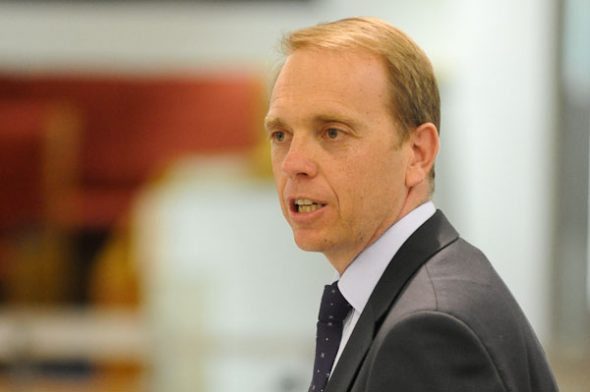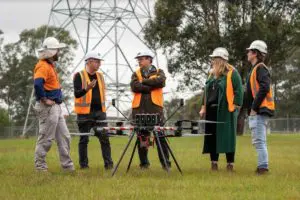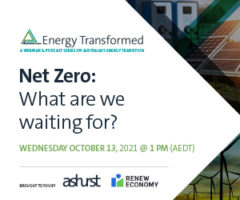The ACT government has launched what many in the solar industry believes to be the most progressive policy mechanism in this country, a reverse-auction to set a feed-in-tariff for large scale solar. Contracts for some 40MW of solar PV capacity will be awarded on this basis, with a further 170MW of solar and other renewables to be auctioned in coming years.
Will it work? RenewEconomy interviewed ACT Energy Minister Simon Corbell, in which he says that the auction could redefine the cost curve of solar PV in this country. And as solar costs come down, and wholesale costs rise, Corbell says the scheme has the flexibility to become self-funding at some point.
Why is the ACT government doing this? It sounds like a risky venture.
We have put together a scheme that I think delivers the lowest risk possible to the community. Why? We believe that community support investment by the government to deliver renewable energy, but I think more importantly it is the strategic positioning of the city as early adopter when it comes to new technologies. Canberra already has the highest percentage of green star rated buildings in the country. And the city is seeking to position itself as a sustainable city and an early adopter of new technologies.
You have said that you want Canberra to be the solar capital of the country. Will that involve an industrial base? Can Canberra have one of those?
Our city is about smart technology, knowledge capital, using the intellectual firepower of the city to drive economic activity and growth in our economy. So, investing in policy measures that will drive supply of renewables on a scale that hasn’t been delivered in Australia before fits very much in that objective.
Shouldn’t this be the province of the federal government, rather than the province of the state and territory governments?
Well, I think the federal government has a very important role to play and the reforms through the clean energy package, the new finance corporation, they all have important roles to play and we look forward to seeing those deployed. But we set ourselves on a path a number of years ago to deliver renewable energy for our city, and we have chosen the mechanism which we believe is the most effective way of delivering that.
What are the cost estimates then of this large scale reverse auction procedure? Have you done the estimates for the initial 40MW tranche and have you estimated for the 210MW that you ultimately intend to roll out?
It’s worth highlighting that the reverse auction will allow us to achieve a very competitive price for solar. And that is the beauty and the strength of the reverse auction. In particular, the element of the reverse auction that will help deliver that is what is called the contract for difference, where we will only be paying the difference between the FiT price that has been agreed to and the wholesale price of electricity in the NEM.
That really means that we are getting a very efficient price for our renewable energy generation. And as the average wholesale price continues to rise, the amount of payment that has to be collected through a FiT and passed on decreases. Over time, we expect the amount of FiT that is recovered through the consumers will go down significantly. We expect for the 40MW the highest pass through cost – once the 40MW are deployed – will be about $1 per household per week.
And that is based on what sort of range on bidding for those contracts?
There is some level of estimate for these things, because it does come down to the level of bidding in the reverse auction, and an estimate as to what will be the increase in the wholesale electricity price over the next 15-20 years, which is the length of FiT. We are proposing a mechanism where we only pay the difference.
Are the renewable energy certificates included ?
We want to see what the options are, we would expect bids with RECs either included or surrendered to the territory. So we will be looking at price from both perspectives. My preference would be that those RECs re surrendered to the territory.
At what stage will that be decided?
That will be part of the negotiations that we conduct. It will first be part of the assessment, and then as part of that assessment, we will ask them to provide bids that includes options for surrendering the RECs, and to put forward a price where deal with the RECs.
Have your advisors given you a range of bidding they expect to be achieved?
Yes they have, but I will not disclose that.
How do you ensure that there are no cowboys in this auction, because going to the cheapest doesn’t necessarily mean the best.
That has been one of the risks with the reverse auction overseas. That’s why we established a two stage process. First of all, all bids have to demonstrate their financial and technical credentials to deliver the project on the ground. No-one is going to be able to bid a price until they have gone through that pre-qualification process. Secondly, we will have start and complete dates in any final contract. We will be requiring generators to start by certain date, in terms of construction of plant, to complete by certain date. We will certainly look at mechanisms for penalties if those dates are not met, and importantly, and this is the ultimate incentive, they don’t get the payment until they start generating.
The other point of concern was that the ACT has the unique situation of having a single utility, Actew AGL, which is a declared bidder for the projects but also the gatekeeper of connections for other contenders. How are you managing that potential conflict of interest?
That is an issue that we have had close regard to. The first thing we have done is to ensure that there are at least two winners in the first round, so it cannot be seen as a lay-down mazaire for Actew AGL, so the government is serious that there will be other generators in the market. In terms of access to network, we will ensure our electrical regulator and our competition regulator have the resources they need to ensure that these issues are appropriately managed. A lot of attention has been paid to that.
Sounds like you are confident that Actew AGL will be successful bidder in the first round
No, I’m not saying that at all. What I am saying is that we wanted to avoid the perception that there is only going to be one successful bidder. We are making it clear it is not a closed shop, there is genuine competition and Actew AGL are going to have to compete on price against every other bidder.
When do expect to have the first solar plant to be commissioned?
That will depend on the scale of the plants that are successful in the auction. Smaller plants will be quicker to deploy, and we are potentially looking at plants of 2MW to 5MW, as well as potentially 15MW to 20MW. We’re very optimistic that we will see work on the ground commence later this year and would not be surprised to plants up and running in 2013.
You have a territory election this year, how protected is this scheme from future policy decisions if there is a change in government?
Well, obviously the legislation has been passed by current assemble. There is strong support for it in the community. The first auction will see the entering into a legally binding contract, so that can be banked on with a high degree of certainty. Should a future alternative government decide not to continue with further auctions, that is a matter for them, but it won’t compromise the first auction round.
If you do get back into government , you have talked about a 210MW program. I’m not sure if there is enough room in Canberra for that much solar. Will it be just solar?
We’re looking at other renewables down the track, so for the 210MW, the legislation gives the government discretion to award bids that are in the broader ACT region. It recognizes that renewable energy plants may be established in immediate region , we have a very strong wind resource in immediate region though not in the ACT itself, so we not ruling out supporting wind or solar, or indeed other technologies such as waste to energy technology. We have the capacity to deploy bids in a targeted way to support our objectives, and it is not just about greenhouse gas abatement, we also have objectives in waste reduction, we want to push our resource recovery rate from around 70 per cent to close to 90 per cent, and that will only be achieved with some waste to energy technology. But this auction is focused on solar generation inside the boundaries of the territory and we believe there is plenty of capacity for that.
Going back to costs, is there a point at which bids do not come in at range you were expecting and so may not deliver the value you are looking for.
Well, that is speculative. It’s not something that I can comment on. All the advice I have to date is that we are looking at a very competitive market, from a large number of bidders. We’ve had over 120 registered parties comes to the expressions of interest process, a very strong level of interest from generators, financiers, and a range of other parties. I think that demonstrates that we will have a very competitive bid.
Presumably then, you are hoping that the result of this is a tender that defies a lot of the predictions about the cost profile of solar in this country?
I think this really will demonstrate that the cost profile of solar is much more competitive than people think it is. And that is to the advantage of the territory and will highlight the strength of the reverse auction process. We do consider that $1 a week per household to be a maximum possible price impact. If wholesale electricity prices reach parity with FiT price, there will be no more FiT cost to consumers, and that would be an excellent outcome. We believe it is a possibility that we will reach parity in the 15-20 year term, but it is difficult to predict.










